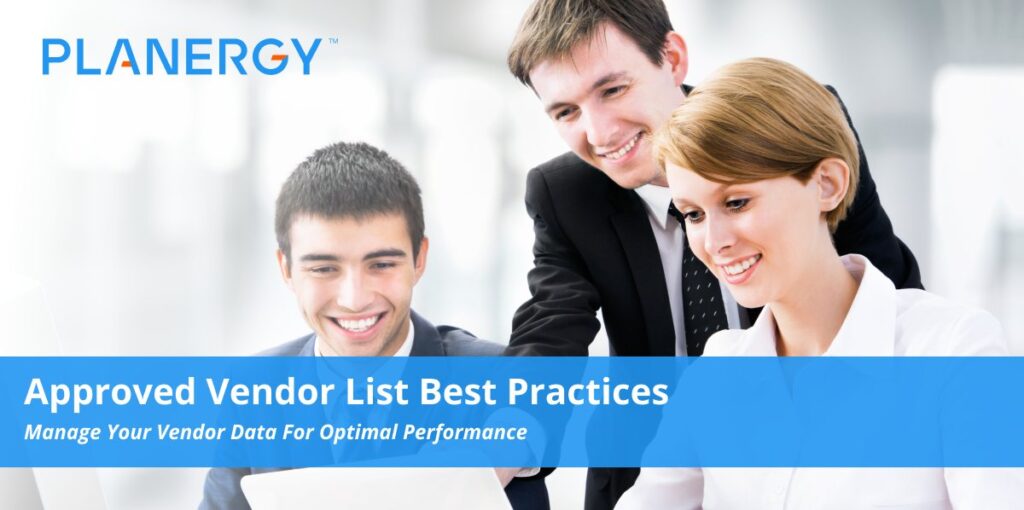If you work in a purchasing department in any capacity, chances are you’ve dealt with several of your most important suppliers regularly.
But while all suppliers have a role to play in your organization, it’s all too easy for the “superstar” strategic suppliers to garner most of the time, attention, and relationship building, while the files for less influential vendors may slowly pass out of date or even become redundant or misplaced.
Effective vendor management requires a comprehensive and intelligent approach to collecting, organizing, and managing vendor data.
Creating and maintaining a complete and up-to-date approved vendor list is one of the most effective ways to achieve this goal.
By updating your methods and implementing the right technological toolset, you can ensure your approved vendor list is optimized to support your business processes and the overall growth and success of your organization.
Why You Need a Better Approved Vendors List
In its ideal form, your approved vendors list is just one well-optimized document connected through a shared data management system, feeding supplier information to your procurement, accounting, marketing, and other business units.
With help from automation and artificial intelligence, such a list can be used to auto-populate a purchase order, verify information on an invoice against shipping documents and existing PO, or provide pricing and other information for analysis and comparison with other vendors to eliminate redundancies, reveal opportunities for new markets, products, and contracts, and create savings as well as value in supporting overall organizational goals.
The age of pen and paper, manual processes is dead, if not quite yet buried. In the interconnected global marketplace, collecting and recording vendor data is difficult enough with manual processes.
Trying to monitor your vendor contact, performance, and contract data for accuracy and completeness not only costs you plenty in wasted time and human error, but potentially opens your organization up to needless risk.
If your company is committed to successful vendor management process, building one begins with an optimized approved vendor list.
Sharing data in the cloud means it’s easy to capture and connect basic information such as supplier contact information with more advanced data sets such as a given vendor’s contract details, performance history, and compliance record. Key stakeholders can use vendor performance and compliance data to negotiate more beneficial contracts, map out new sourcing strategies, and strengthen relationships with your best suppliers through product innovation or new shared market initiatives.
Crafting a Best Approved Vendor List
Traditionally, the process of building your approved vendor looked something like this:
- Identify and list all current vendors providing goods and services.
- Review existing contracts.
- Review existing Accounts Payable (AP) listings.
- Identify and assign each vendor to the appropriate stakeholder.
- Send each stakeholder a list of the vendors under their purview and request that they:
- Confirm each vendor’s contact, contract, and performance information (if available).
- Confirm that they are still using each vendor.
- Describe the goods or services provided by each vendor.
- Rate each vendor’s overall performance (e.g., a scale of 1-5 where 1 is “unacceptable” and 5 is “exceptional”).
- Verify whether each vendor has access to proprietary or protected company data.
- Identify the vendor’s role as:
- Critical—Vendor supplies goods and services essential to the continued operation and success of your organization. They may also have access to proprietary intellectual property, protected data, or customer information, making compliance failures especially risky.
- Important—Vendor supplies goods and services that could be costly to replace in an emergency without effectively contingency planning, but would not cripple the business with a disruption. They may have access to limited sensitive data.
- Useful—Ideally, all of your company’s suppliers are useful. The potential expense created by disruption in supplied goods and services is minimal, and these vendors do not have access to sensitive data.
- Update the list with any vendors not already included.
- Create, monitor, and manage a master approved vendor list based on feedback from stakeholders.
At a glance, it’s clear that this process is susceptible to a number of potential problems if executed in an analog environment.
Human error, lost documents, and delays in communication can have your staff chasing down information and correcting errors instead of collaborating and sharing data to improve processes, build stronger vendor relationships, and make strategic sourcing decisions.
Automation and artificial intelligence are two critically important technologies that have become core components of digital transformation and business process management of all kinds—including managing vendor data and relationships.
They make it possible to integrate features such as a vendor portal into your vendor management workflows, allowing your suppliers to submit their own information for review.
In fact, using the right cloud-based procurement solution gives you a bevy of vendor management benefits from day one.
Sharing data in the cloud means it’s easy to capture and connect basic information such as supplier contact information with more advanced data sets such as a given vendor’s contract details, performance history, and compliance record.
Key stakeholders can use vendor performance and compliance data to negotiate more beneficial contracts, map out new sourcing strategies, and strengthen relationships with your best suppliers through product innovation or new shared market initiatives.
In addition, your buyers will appreciate having real-time access to the vendors who best suit the needs their meeting with their purchases.
They won’t have to “step outside” the system looking for short-term bargains, and you’re company will enjoy both savings and increased value from eliminating invoice fraud and rogue spend.
The same vendor portal used by new vendors during supplier onboarding can also be used by existing vendors to connect with your system, share information, and perform important tasks like eInvoicing or service updates.
You’ll capture more discounts, pay your suppliers at optimal times, and enhance the efficacy and speed of your Procure-to-Pay process for the best possible return on investment (ROI).
Supplier Onboarding Best Practices
Building your approved vendor list doesn’t have to be a time-consuming exercise in frustration.
In addition to using artificial intelligence and automation, you can make sure your list is the best it can be by remembering a few simple concepts.
- Educate and Engage Your Whole Team. Depending on your organization’s corporate culture, it will be helpful to choose a supplier management solution that includes training and educational materials to bring your team on board with the new approved vendor list process.
- Automation is Key. Bake continuous improvement into your supply chain at all levels, and enjoy improved efficiency, accuracy, and collaboration between your vendors and your team.
- Get Creative. With so much data at your disposal, it would be a shame to miss out on opportunities hiding within your everyday workflows. Don’t be afraid to collaborate closely with vendors to achieve greater efficiency inside and outside your system, and target areas of shared benefit to enhance your profitability, reputation, and potential for growth and innovation.
Put Effective Vendor Data Management at the Top of Your List
Every vendor on your list is a potential source of value—or should be.
You can make sure your team has access to current, accurate, and complete vendor data when they need it most by building an approved vendor list and then using automation, artificial intelligence, and continuous improvement methodologies to ensure every dollar spent on every single good or service is going to the right vendor, at the right time, and for the best possible ROI.




